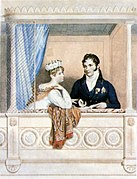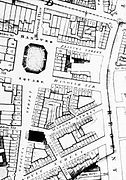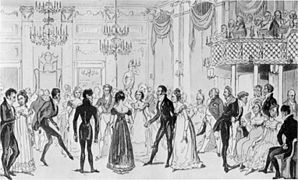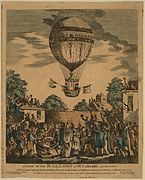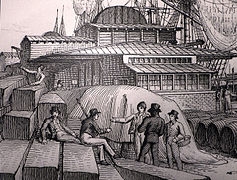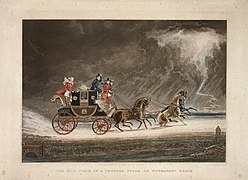Regency era
| Regency era | |||
|---|---|---|---|
| (1795) 1811 – 1837 | |||
 George IV while Prince Regent by Sir Thomas Lawrence | |||
| Monarch(s) | George IV | ||
Chronology
| |||
| Periods in English history |
|---|
| Timeline |
The Regency in Great Britain was a period when King George III was deemed unfit to rule and his son ruled as his proxy as Prince Regent. On the death of George III in 1820, the Prince Regent became George IV. The term Regency (or Regency era) can refer to various stretches of time; some are longer period than the decade of the formal Regency which lasted from 1811–1820. The period 1795 to 1837, which includes the latter part of the reign of George III and the reigns of his sons George IV and William IV, is often attributed as the Regency era characterised by distinctive trends in British architecture, literature, fashions, politics, and culture. The Regency era ended in 1837 when Queen Victoria succeeded William IV.
Society during the Regency
The Regency is noted for its elegance and achievements in the fine arts and architecture. This era encompassed a time of great social, political, and economic change. War was waged with Napoleon and on other fronts, affecting commerce both at home and internationally as well as politics. Despite the bloodshed and warfare the Regency was also a period of great refinement and cultural achievement, shaping and altering the societal structure of Britain as a whole.
One of the greatest patrons of the arts and architecture was the Prince Regent himself (the future George IV). Upper class society flourished in a sort of mini-Renaissance of culture and refinement. As one of the greatest patrons of the arts, the Prince Regent ordered the costly building and refurbishing of the beautiful and exotic Brighton Pavilion, the ornate Carlton House, as well as many other public works and architecture (See John Nash, James Burton, and Decimus Burton). Naturally, this required dipping into the treasury and the Regent, and later, King's exuberance often outstripped his pocket, at the people's expense.[1]
Society was also considerably stratified. In many ways there was a dark side to the beauty and fashion in England at this time. In the dingier, less affluent areas of London, thievery, womanising, gambling, the existence of rookeries, and constant drinking ran rampant.[2] The population boom—the population increased from just under a million in 1801 to one and a quarter million by 1820[2]—created a wild, roiling, volatile, and vibrant scene. According to Robert Southey, the difference between the strata of society was vast indeed:
The squalor that existed beneath the glamour and gloss of Regency society provided sharp contrast to the Prince Regent's social circle. Poverty was addressed only marginally. The formation of the Regency after the retirement of George III saw the end of a more pious and reserved society, and gave birth of a more frivolous, ostentatious one. This change was influenced by the Regent himself, who was kept entirely removed from the machinations of politics and military exploits. This did nothing to channel his energies in a more positive direction, thereby leaving him with the pursuit of pleasure as his only outlet, as well as his sole form of rebellion against what he saw as disapproval and censure in the form of his father.[3]
Driving these changes was not only money and rebellious pampered youth, but also significant technological advancements. In 1814 The Times adopted steam printing. By this method it could now print 1,100 sheets every hour, not 200 as before—a fivefold increase in production capability and demand.[4] This development brought about the rise of the wildly popular fashionable novels in which publishers spread the stories, rumours, and flaunting of the rich and aristocratic, not so secretly hinting at the specific identity of these individuals. The gap in the hierarchy of society was so great that those of the upper classes could be viewed by those below as wondrous and fantastical fiction, something entirely out of reach yet tangibly there.
Timeline of the formal Regency
- 1811
- George Augustus Frederick, Prince of Wales[5] began his nine-year tenure as regent and became known as The Prince Regent. This sub-period of the Georgian era began the formal Regency. The Duke of Wellington held off the French at Fuentes d'Onoro and Albuhera in the Peninsular War. The Prince Regent held a fete at 9:00 p.m. June 19, 1811, at Carlton House in celebration of his assumption of the Regency. Luddite uprisings. Glasgow weavers riot.
- 1812
- Spencer Perceval assassinated in the House of Commons. Final shipment of the Elgin Marbles arrived in England. Sarah Siddons retired from the stage. Shipping and territory disputes started the War of 1812 between the United Kingdom and the United States. The British were victorious over French armies at the Battle of Salamanca. The waltz was introduced from Europe into England. Gas company (Gas Light and Coke Company) founded. Charles John Huffam Dickens English writer and social critic of the Victorian era was born on 7 February 1812
- 1813
- Pride and Prejudice by Jane Austen was published. William Hedley's Puffing Billy, an early steam locomotive, ran on smooth rails. Quaker prison reformer Elizabeth Fry started her ministry at Newgate Prison. Robert Southey became Poet Laureate.
- 1814
- Invasion of France by allies led to the Treaty of Paris, ended one of the Napoleonic Wars. Napoleon abdicated and was exiled to Elba. The Duke of Wellington was honored at Burlington House in London. British soldiers burn the White House. Last River Thames Frost Fair was held, which was the last time the river froze. Gas lighting introduced in London streets.
- 1815
- Napoleon I of France defeated by the Seventh Coalition at the Battle of Waterloo. Napoleon was exiled to St. Helena. The English Corn Laws restricted corn imports. Sir Humphry Davy patented the miners' safety lamp. John Loudon Macadam's road construction method adopted.
- 1816
- Income tax abolished. A "year without a summer" followed a volcanic eruption in Indonesia. Mary Shelley wrote Frankenstein. William Cobbett published his newspaper as a pamphlet. The British returned Indonesia to the Dutch. Regent's Canal, London, phase one of construction. Beau Brummell escaped his creditors by fleeing to France.
- 1817
- Antonin Carême created a spectacular feast for the Prince Regent at the Royal Pavilion in Brighton. The death of Princess Charlotte from complications of childbirth changed obstetrical practices. Elgin Marbles shown at the British Museum. Captain Bligh died.
- 1818
- Queen Charlotte died at Kew. Manchester cotton spinners went on strike. Riot in Stanhope between lead miners and the Bishop of Durham's men over Weardale gaming rights. Piccadilly Circus constructed in London.
- 1819
- Peterloo Massacre. Princess Alexandrina Victoria (future Queen Victoria) was christened in Kensington Palace. Ivanhoe by Walter Scott was published. Sir Stamford Raffles, a British administrator, founded Singapore. First steam-propelled vessel (the SS Savannah) crossed the Atlantic and arrived in Liverpool from Savannah, Georgia.
- 1820
- Death of George III. Accession of The Prince Regent as George IV. The House of Lords passed a bill to grant George IV a divorce from Queen Caroline, but because of public pressure the bill was dropped. John Constable began work on The Hay Wain. Cato Street Conspiracy failed. Royal Astronomical Society founded. Venus de Milo discovered.
Places
The following is a list of places associated with the Regency era:

- The Adelphi Theatre[6]
- Almack's
- Astley's Amphitheatre
- Attingham Park[7]
- Bath, Somerset
- Brighton Pavilion
- Brighton and Hove
- Brooks's
- Burlington Arcade
- Bury St Edmunds
- Carlton House, London
- Chapel Royal, St. James's
- Cheltenham, Gloucestershire
- Circulating libraries, 1801–25[8]
- Covent Garden
- Custom Office, London Docks
- Doncaster Races[9]
- Drury Lane
- Floris of London
- Fortnum & Mason
- Gretna Green[10]
- Hatchard's
- Little Theatre, Haymarket
- Her Majesty's Theatre
- Holland House
- Houses of Parliament
- Hyde Park, London
- Jermyn Street
- Kensington Gardens[11]
- King of Clubs (Whig club)
- List of London's gentlemen's clubs
- Lloyd's of London
- London Docks
- London Institution
- London Post Office[10]
- Lyme Regis
- Marshalsea Debtor's Prison
- Mayfair, London
- Newgate Prison
- Newmarket Racecourse
- The Old Bailey
- Old Bond Street
- Opera House[12]
- Pall Mall, London
- The Pantheon
- Ranelagh Gardens
- Regent's Park
- Regent Street
- Royal Circus[12]
- Royal Opera House
- Royal Parks of London
- Rundell and Bridge Jewellery firm
- Savile Row
- St George's, Hanover Square
- St. James's
- Sydney Gardens, Bath[11]
- Temple of Concord, St. James's Park
- Tattersalls
- The Thames Tunnel
- Tunbridge Wells
- Vauxhall Gardens
- West End of London
- Watier's
- White's
Important people
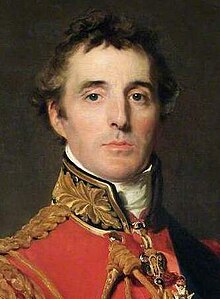
- Rudolph Ackermann
- Arthur Aikin
- Henry Addington, 1st Viscount Sidmouth
- William Arden, 2nd Baron Alvanley, Prinny's set
- Elizabeth Armistead
- Jane Austen
- Charles Babbage
- Joseph Banks
- Richard Barry, 7th Earl of Barrymore, Prinny's set
- William Blake
- Beau Brummell
- Mary Brunton
- Lord Frederick Beauclerk
- Henrietta Ponsonby, Countess of Bessborough
- Marguerite, Countess of Blessington
- Bow Street Runners
- Caroline of Brunswick, Prinny's wife
- Frances Burney
- James Burton
- Decimus Burton
- George Gordon, Lord Byron
- George Campbell, 6th Duke of Argyll, Prinny's set
- Robert Stewart, Viscount Castlereagh
- George Cayley
- Georgiana Cavendish, Duchess of Devonshire
- Princess Charlotte Augusta of Wales
- William Cobbett
- Samuel Taylor Coleridge
- Patrick Colquhoun
- John Constable
- Elizabeth Conyngham, Marchioness Conyngham
- Tom Cribb
- George Cruikshank
- John Dalton
- Humphry Davy
- John Disney
- David Douglas
- Maria Edgeworth
- Pierce Egan
- Thomas Bruce, 7th Earl of Elgin
- Grace Elliott
- Maria Fitzherbert
- Elizabeth Fry
- David Garrick
- George IV of the United Kingdom, Prince of Wales, Prince Regent then King
- James Gillray
- Frederick Robinson, 1st Viscount Goderich
- William Grenville, 1st Baron Grenville
- Charles Grey, 2nd Earl Grey
- Emma, Lady Hamilton
- William Harcourt, 3rd Earl Harcourt
- William Hazlitt
- William Hedley
- Leigh Hunt
- Isabella Ingram-Seymour-Conway, Marchioness of Hertford
- John Jackson
- Edward Jenner
- Sarah, Countess of Jersey
- Edmund Kean
- John Keats
- Lady Caroline Lamb
- Charles Lamb
- Emily Lamb, Countess Cowper
- Sir Thomas Lawrence, PRA
- Princess Lieven
- Mary Linwood
- Robert Jenkinson, 2nd Earl of Liverpool
- Ada Byron Lovelace
- John Loudon McAdam
- Hannah More
- John Nash
- Horatio Nelson, 1st Viscount Nelson
- George Ormerod
- Henry Paget, 1st Marquess of Anglesey
- John Palmer, Royal Mail
- John Clare (poet)
- Spencer Perceval
- Jane Porter
- Hermann, Fürst von Pückler-Muskau
- Thomas de Quincey
- Thomas Raikes
- Humphry Repton
- Samuel Rogers
- Thomas Rowlandson
- James Sadler
- Walter Scott
- Richard "Conversation" Sharp
- Percy Bysshe Shelley
- Mary Shelley
- Richard Sheridan
- Sarah Siddons
- John Soane
- Adam Sedgwick
- Robert Stewart, Viscount Castlereagh
- John Wedgwood
- Arthur Wellesley, 1st Duke of Wellington
- Benjamin Thompson, Count Rumford
- Joseph Mallord William Turner
- Henry Vassall-Fox, 3rd Baron Holland
- Thomas Young (scientist)
- Benjamin West
- William Wilberforce
- William Hyde Wollaston
- William Wordsworth
- Jeffry Wyattville
Newspapers, pamphlets, and publications
- Ackermann's Repository
- The Gentleman's Magazine
- British Journalists 1750–1820[13]
- Newspapers in the Regency era[14]
- The Times
- The Observer
- Weekly Political Register, William Cobbett
- La Belle Assemblée
The British Regency in popular culture

- The Madness of King George
- Regency Reenactment Groups
- Regency novels
- Regency romance
- Jane Austen in popular culture
- Republic of Pemberley
- The third series of the BBC comedy series Blackadder is set in the Regency Period.
- The British Regency Period in film and costume dramas[15]
See also
- Regency architecture
- Regency fashions
- Regency dance
- Régence, the period of the early 18th-century regency in France
- Society of Dilettanti
Images from the British Regency
-
Necklothitania,1818
-
Astley's Amphitheatre, 1808-1811
-
Brighton Pavilion, 1826
-
Carlton House, Pall Mall London.
-
Vauxhall Gardens, 1808–1811
-
Church of All Souls, architect John Nash, 1823
-
Regent's Canal, Limehouse, 1823
-
Frost Fair, Thames River, 1814
-
The Piccadilly entrance to the Burlington Arcade, 1819
-
Princess Charlotte Augusta of Wales and Leopold I, 1817
-
Morning dress, Ackermann, 1820
-
Water at Wentworth, Humphry Repton, 1752–1818
-
Hanover Square, Horwood Map, 1819
-
Beau Brummell, 1805
-
Battle of Waterloo, 1815
-
Almack's Assembly Room, 1805–1825
-
Drury Lane interior. 1808
-
Balloon ascent, James Sadler, 1811
-
The Anatomist, Thomas Rowlandson, 1811
-
Regent's Park, Schmollinger map, 1833
-
100 Pall Mall, former location of National Gallery, 1824–1834
-
Cognocenti, Gillray Cartoon, 1801
-
Custom Office, London Docks, 1811-1843
-
Custom and Excise, London Docks, 1820
-
Mail coach, 1827
-
Assassination of Spencer Perceval, 1812
-
The pillory at Charing Cross, Ackermann's Microcosm of London, 1808–11
-
Covent Garden Theatre, 1827–28
References
- ^ Parissien, Steven. George IV Inspiration of the Regency. New York: St. Martin's P, 2001. 117
- ^ a b Low, Donald A. The Regency Underworld. Gloucestershire: Sutton, 1999. x
- ^ Smith 14.
- ^ Morgan, Marjorie. Manners, Morals, and Class in England, 1774–1859. New York: St. Martin's P, 1994. 34.
- ^ "George IV (r. 1820–1830)". The Royal Household. Retrieved 12 April 2015.
- ^ Nelson, Alfred L.; Cross, Gilbert B. "The Adelphi Theatre, 1806–1900". Archived from the original on 8 June 2007.
- ^ "Attingham Park: History". National Trust. Retrieved 12 April 2015.
- ^ "Circulating Libraries, 1801–1825". Library History Database. Archived from the original on 14 April 2008. Retrieved 12 April 2015.
- ^ "Jane Austen: Sports". Jane's Bureau of Information. Archived from the original on 13 September 2008. Retrieved 12 April 2015.
{{cite web}}:|archive-date=/|archive-url=timestamp mismatch; 9 May 2008 suggested (help) - ^ a b "Jane Austen: Places". Jane's Bureau of Information. Archived from the original on 8 May 2008. Retrieved 12 April 2015.
- ^ a b "Jane Austen: Gardens". Jane's Bureau of Information. Archived from the original on 13 May 2008. Retrieved 12 April 2015.
- ^ a b "Jane Austen: Theatre". Jane's Bureau of Information. Archived from the original on 13 May 2008. Retrieved 12 April 2015.
- ^ "British Journalists 1750–1820". Spartacus Educational. Retrieved 12 April 2015.
- ^ "Newspapers and publishers at dawn of 19th century". Georgian Index. Retrieved 12 April 2015.
- ^ "An Introduction to the British Regency Period". PeriodDramas.com. Retrieved 12 April 2015.
Further reading
- Bowman, Peter James. The Fortune Hunter: A German Prince in Regency England. Oxford: Signal Books, 2010.
- David, Saul. Prince of Pleasure The Prince of Wales and the Making of the Regency. New York: Atlantic Monthly Press, 1998.
- Knafla, David, Crime, punishment, and reform in Europe, Greenwood Publishing, 2003
- Lapp, Robert Keith. Contest for Cultural Authority – Hazelitt, Coleridge, and the Distresses of the Regecy. Detroit: Wayne State UP, 1999.
- Low, Donald A. The Regency Underworld. Gloucestershire: Sutton, 1999.
- Morgan, Marjorie. Manners, Morals, and Class in England, 1774–1859. New York: St. Martin's P, 1994.
- Parissien, Steven. George IV Inspiration of the Regency. New York: St. Martin's P, 2001.
- Pilcher, Donald. The Regency Style: 1800–1830 (London: Batsford, 1947).
- Rendell, Jane. The pursuit of pleasure: gender, space & architecture in Regency London (Bloomsbury, 2002).
- Simond, Louis. Journal of a tour and residence in Great Britain, during the years 1810 and 1811 online
- Smith, E. A. George IV. New Haven and London: Yale UP, 1999.
- Wellesley, Lord Gerald. "Regency Furniture," The Burlington Magazine for Connoisseurs 70, no. 410 (1973): 233–41.
- White, R.J. Life in Regency England (Batsford, 1963).










